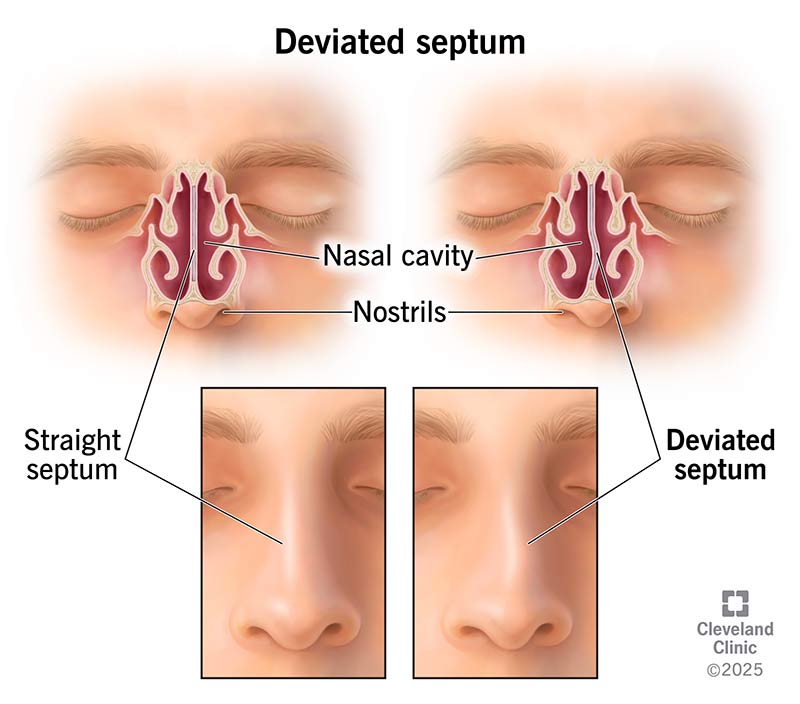A deviated septum occurs when your septum, the cartilage and bone that separates your nasal cavity, is off-center. Some people are born with a deviated septum. For others, a nose injury causes it. A badly deviated septum may cause breathing problems, congestion and headaches. Surgery called septoplasty can repair a deviated septum.
Advertisement
Cleveland Clinic is a non-profit academic medical center. Advertising on our site helps support our mission. We do not endorse non-Cleveland Clinic products or services. Policy

A deviated septum is when the bone and cartilage that divides your nasal cavity and/or nostrils is off-center. Your nasal septum is the tissue that separates the right and left sides of your nasal cavity. A perfectly straight nasal septum creates two equally-sized nasal cavities. Air flows freely through both.
Advertisement
Cleveland Clinic is a non-profit academic medical center. Advertising on our site helps support our mission. We do not endorse non-Cleveland Clinic products or services. Policy
But about 8 out of 10 people — so, most of us — have a nasal septum that’s a little off-center. Lots of people don’t realize it because they don’t have symptoms.
If you have a more pronounced deviation, though, air may have a harder time flowing through your nose. This can make it harder to breathe. It may make you more likely to have nosebleeds and other issues.
A severely deviated septum may make your nose look off-center. If it’s not noticeable when you’re looking straight on in the mirror, take a picture of the underside of your nose. If your nostrils are uneven or different sizes, you may have a deviated septum.
Other deviated septum symptoms may include:
You can be born with a nasal septum deviation. A difficult delivery can injure your nasal septum. As your nose grows, your septum also grows and can sometimes lean more toward one side. This is the most common deviated septum cause.
Other causes include an injury, like a broken nose.
Activities or events that lead to a nose injury increase your risk. Examples include:
Advertisement
You can’t avoid all risks. But you can take precautions, like wearing a seatbelt. You can wear protective gear (like a midface mask and helmet) when playing contact sports.
Minor nasal septum deviation may not cause any issues at all. But a severely deviated septum can cause problems like:
A healthcare provider will examine your nose using a nasal speculum. This handheld instrument gently spreads your nostrils open so your provider can see the inside of your nose. They’ll look at your septum to see if it affects the size of your nasal passages.
You may also need tests that show tissue deeper inside your nose, including:
Most people don’t need deviated septum treatment because they have little to no symptoms. You can treat mild symptoms with medication. But if a deviated nasal septum keeps you from breathing properly, you might need surgery.
Mild septal deviation may cause occasional symptoms. They may not show up until you get sick. You can treat these symptoms with over-the-counter (OTC) medications, including:
But don’t use nasal decongestant sprays for more than three days in a row. It could cause rebound congestion.
The only way to fix a deviated septum is with septoplasty. This surgery may be an option if you have breathing problems or other bothersome symptoms. During a septoplasty, a surgeon reshapes your septum.
If your child needs surgery, their surgeon may wait to do a septoplasty until their nose finishes growing. Usually, this happens in a child’s mid-teens.
Sometimes, a septoplasty happens alongside a rhinoplasty. This surgery reshapes your nose. It may help if you’re unsatisfied with how your nose looks.
Talk to a provider if your symptoms interfere with breathing, disrupt your sleep or have a negative impact on other aspects of your life.
If you think you have a broken nose, go to your nearest emergency room (ER).
Usually, having a deviated septum doesn’t affect your quality of life. An untreated deviated symptom may not cause issues at all. You may be able to manage mild symptoms with over-the-counter medications.
But the only way to fix, or cure, a nasal deviated septum is with surgery. If you have symptoms that interfere with your quality of life, ask your healthcare provider if surgery is an option.
Advertisement
In most cases, you can’t tell if you have a deviated septum just by feeling it. But people with severe nasal deviation might be able to tell that their septum is off-center.
You might be able to tell by taking the deviated septum self-test:
This test can be helpful. But the only surefire way to know if you have a deviated septum is to get a diagnosis from a healthcare provider.
You shouldn’t try to push your septum back into place under any circumstances. If a traumatic event like a car crash injures your nose, head to your nearest emergency room right away.
It’s possible. As you grow, individual body parts, like your nasal septum, can change. With age, a slightly deviated septum can become more off-center.
Unless you have symptoms, you probably haven’t given the delicate tissue between your nostrils — your nasal septum — a thought. Even when it’s slightly deviated, it usually doesn’t cause issues. But if you have trouble breathing or constantly get nosebleeds, tell your healthcare provider. They can diagnose a deviated septum and recommend appropriate treatment.
Advertisement
A deviated septum can make it hard to breathe. Cleveland Clinic experts can help you breathe easier with septoplasty.

Last reviewed on 08/18/2025.
Learn more about the Health Library and our editorial process.